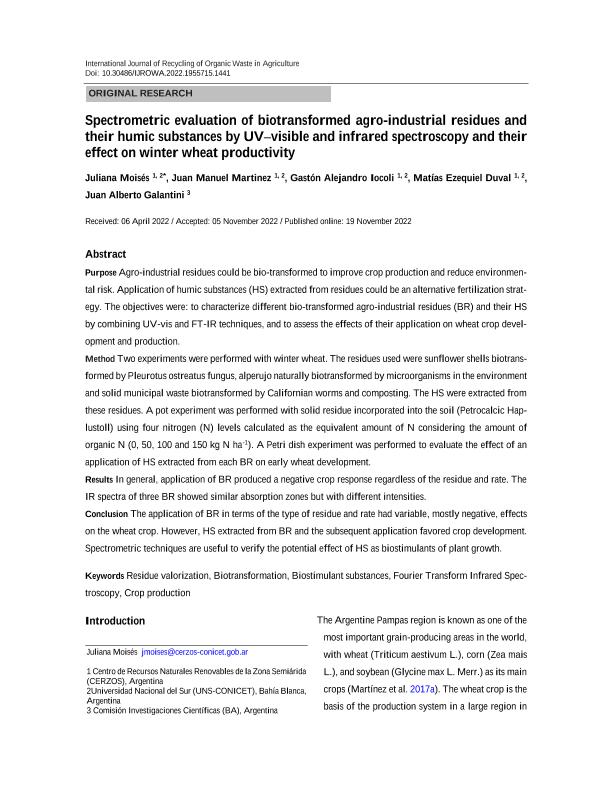Artículo
Spectrometric evaluation of biotransformed agro-industrial residues and their humic substances by UV–visible and infrared spectroscopy and their effect on winter wheat productivity
Moisés, Juliana ; Martinez, Juan Manuel
; Martinez, Juan Manuel ; Iocoli, Gastón Alejandro
; Iocoli, Gastón Alejandro ; Duval, Matias Ezequiel
; Duval, Matias Ezequiel ; Galantini, Juan Alberto
; Galantini, Juan Alberto
 ; Martinez, Juan Manuel
; Martinez, Juan Manuel ; Iocoli, Gastón Alejandro
; Iocoli, Gastón Alejandro ; Duval, Matias Ezequiel
; Duval, Matias Ezequiel ; Galantini, Juan Alberto
; Galantini, Juan Alberto
Fecha de publicación:
07/2023
Editorial:
Islamic Azad University
Revista:
International Journal of Recycling of Organic Waste in Agriculture
ISSN:
2195-3228
e-ISSN:
2251-7715
Idioma:
Inglés
Tipo de recurso:
Artículo publicado
Clasificación temática:
Resumen
Purpose Agro-industrial residues could be bio-transformed to improve crop production and reduce environmental risk. Application of humic substances (HS) extracted from residues could be an alternative fertilization strategy. The objectives were: to characterize different bio-transformed agro-industrial residues (BR) and their HSby combining UV-vis and FT-IR techniques, and to assess the effects of their application on wheat crop development and production.Method Two experiments were performed with winter wheat. The residues used were sunflower shells biotransformed by Pleurotus ostreatus fungus, alperujo naturally biotransformed by microorganisms in the environmentand solid municipal waste biotransformed by Californian worms and composting. The HS were extracted fromthese residues. A pot experiment was performed with solid residue incorporated into the soil (Petrocalcic Haplustoll) using four nitrogen (N) levels calculated as the equivalent amount of N considering the amount oforganic N (0, 50, 100 and 150 kg N ha-1). A Petri dish experiment was performed to evaluate the effect of anapplication of HS extracted from each BR on early wheat development.Results In general, application of BR produced a negative crop response regardless of the residue and rate. TheIR spectra of three BR showed similar absorption zones but with different intensities.Conclusion The application of BR in terms of the type of residue and rate had variable, mostly negative, effectson the wheat crop. However, HS extracted from BR and the subsequent application favored crop development.Spectrometric techniques are useful to verify the potential effect of HS as biostimulants of plant growth.
Archivos asociados
Licencia
Identificadores
Colecciones
Articulos(CERZOS)
Articulos de CENTRO REC.NAT.RENOVABLES DE ZONA SEMIARIDA(I)
Articulos de CENTRO REC.NAT.RENOVABLES DE ZONA SEMIARIDA(I)
Citación
Moisés, Juliana; Martinez, Juan Manuel; Iocoli, Gastón Alejandro; Duval, Matias Ezequiel; Galantini, Juan Alberto; Spectrometric evaluation of biotransformed agro-industrial residues and their humic substances by UV–visible and infrared spectroscopy and their effect on winter wheat productivity; Islamic Azad University; International Journal of Recycling of Organic Waste in Agriculture; 12; 3; 7-2023; 351-366
Compartir
Altmétricas



